Tag: eagle
Thank You to Eagle Project Volunteers
by: Larissa Smith, Senior Biologist
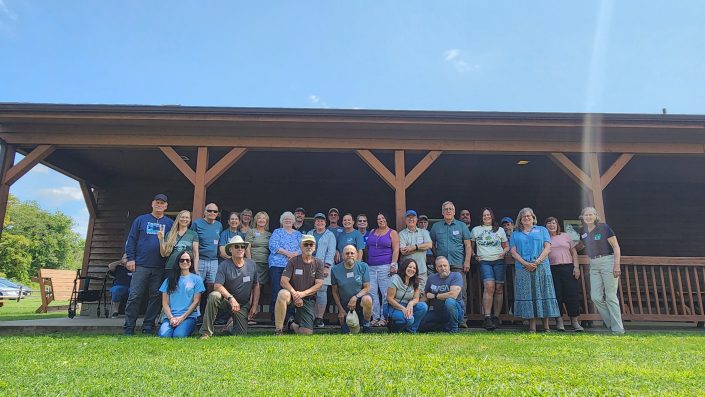
We can never thank the NJ Eagle Project volunteers enough for all they do to monitor and protect eagles in New Jersey. Conserve Wildlife Foundation hosted a get-together at the Assunpink Conservation Center this August as a way to say, “thank you”. There are 162 eagle project volunteers currently monitoring eagle nests statewide and it’s not always easy to get everyone together at one time due to distance and obligations. The volunteers who were able to attend shared stories with other volunteers about the nesting season, received an update on the proposed eagle delisting from ENSP Chief, Kathy Clark and hopefully felt very appreciated. This is down time for the eagle project volunteers, though some eagles are already back and working on their nests. THANK YOU to all the Eagle Project Volunteers.
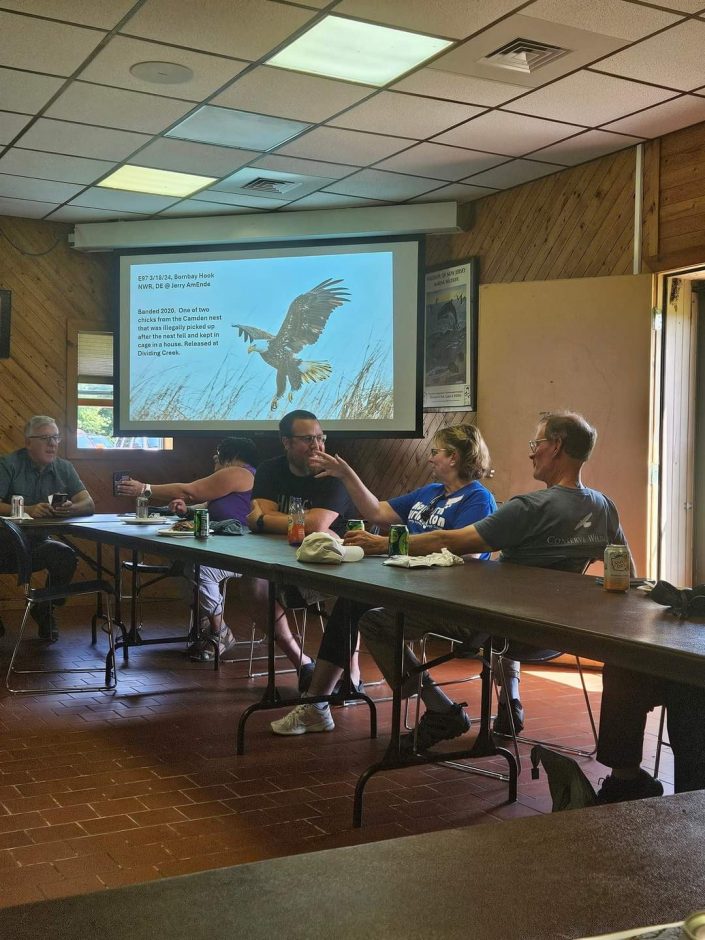

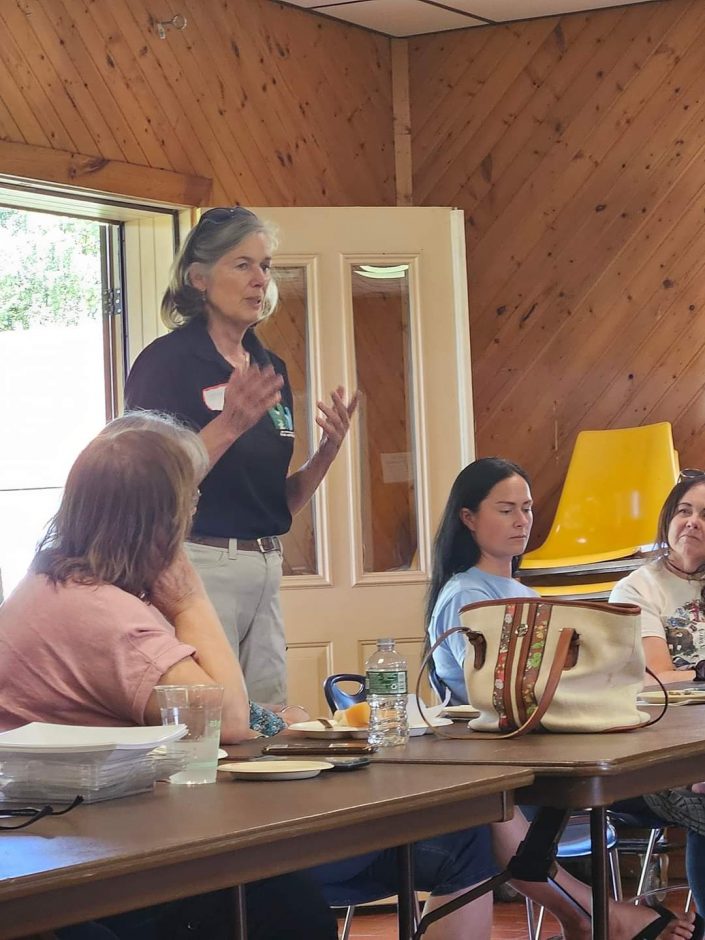
The Bald Eagle project would not be possible without our corporate partners. We would like to thank PSE&G, Wakefern/ShopRite Stores, Wells Fargo Advisors, and the Cape May County Zoo (AAZK) for providing crucial financial and outreach resources to help keep bald eagles soaring above New Jersey.
Birds and Powerlines
Larissa Smith: CWF Senior Biologist,
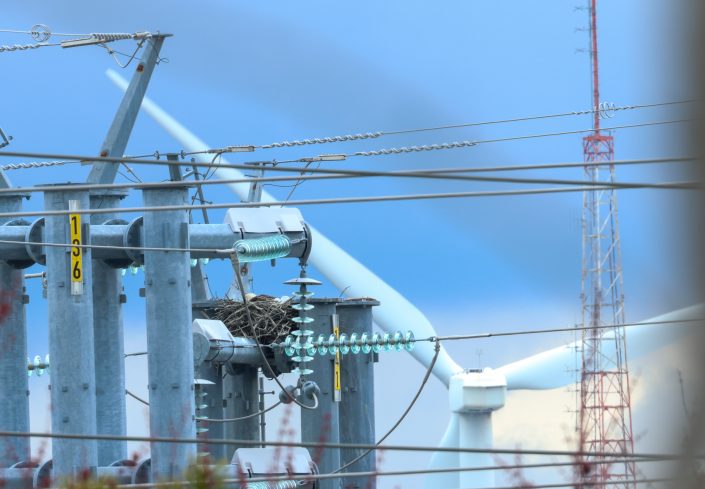
Last week I attended the APLIC (Avian Powerline Interaction Committee) workshop hosted by PSE&G. APLIC is a group that leads the electric utility industry in protecting avian resources while enhancing reliable energy delivery. We all use electricity and power lines are needed to distribute the power to where it’s needed. Powerlines and transmission towers have become a normal part of the landscape and we don’t pay much attention until our power goes out. All different species of birds, from bald eagles to starlings, interact with powerlines, poles and towers daily, including perching and nesting on them.
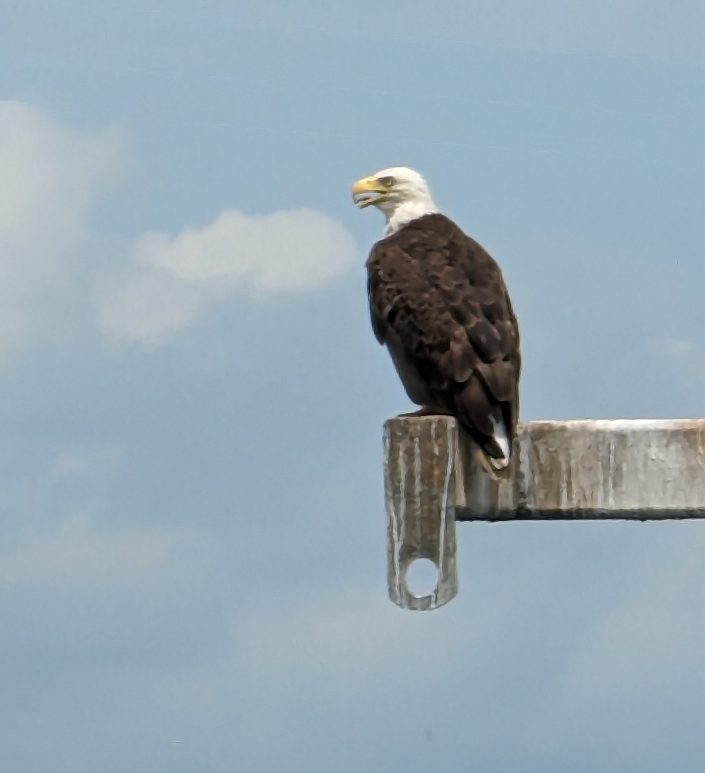

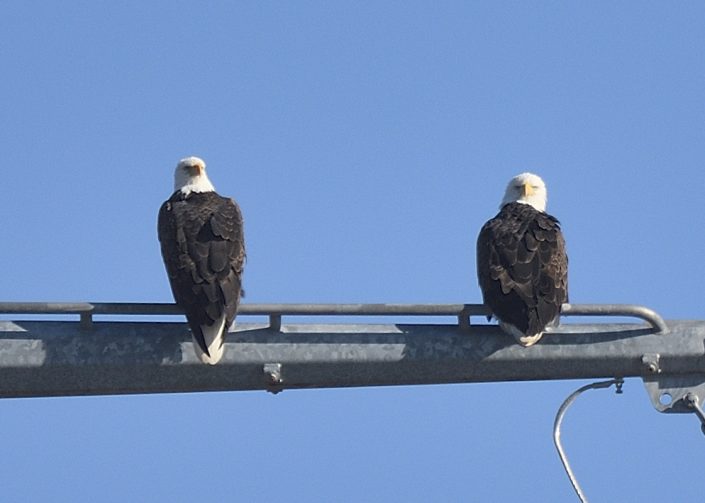
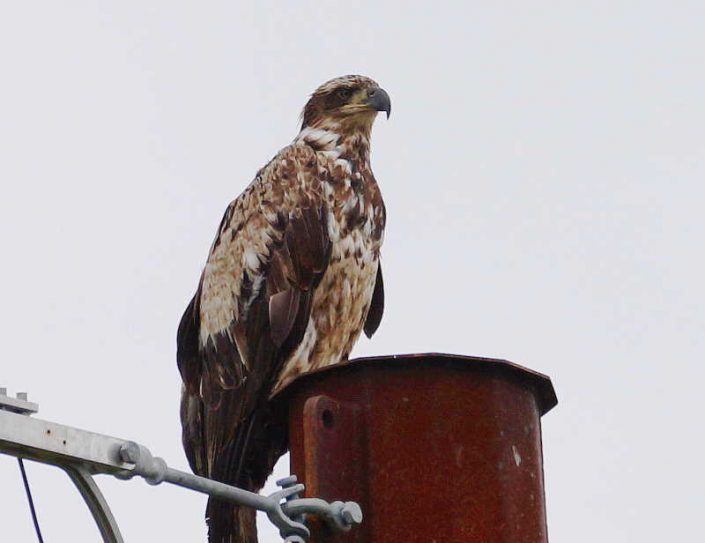

With these interactions come issues, birds can be injured or die from electrocution and collisions which can cause power outages. Nests on poles and transmission towers can create problems with outages and fires as well as risk to chicks or adults. One part of my job is keep track of all reported injured or dead bald eagles in New Jersey. In 2023 there have been fifteen confirmed eagle electrocutions. Any recoveries that are a suspected electrocution or collision with a powerline are reported to the appropriate utility company. CWF and the NJ ENSP have a good relationship with the Utility companies in New Jersey. Each utility company has biologists that work on environmental issues including avian. There are a whole set of issues that they need to be taken into consideration when deciding how best to minimize negative avian interactions. The solutions require time, money and often scheduled power outages. When an area of lines or poles are identified as a risk for bird electrocution/collision, they are made as avian safe as possible. When new distribution lines are rebuilt, avian issues are taken into consideration and the appropriate measures are implemented.
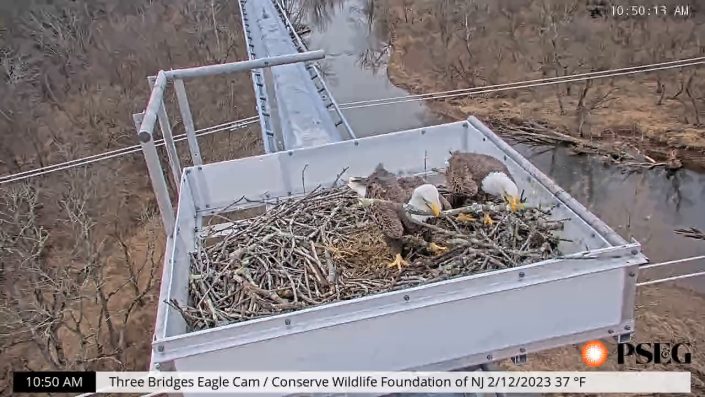
There are quite a few bald eagles and ospreys that nest on poles and transmission towers throughout New Jersey. Most of these nests don’t cause problems, but if they need to be removed, the utility company works to obtain the proper permits and replace the nest with a new nesting structure in close vicinity. One example is the Three Bridges eagle nest. PSE&G needed to replace the entire distribution line where an eagle pair had been nesting on one of the towers for years. After much planning and coordination the nest was removed and placed on a nest platform installed on one of the new towers.
I certainly learned a lot at the workshop and gained a new appreciation for everything that goes into keeping our electricity flowing at the flick of a switch and making sure that avian species stay safe at the same time.
To learn more:
- Avian Powerline Interaction Committee (APIC)
- Three Bridges Eagle Cam (link to blog posts at bottom of eagle cam page)
Empty Nest Syndrome: NJ Eagle Chicks Fledge
by: Larissa Smith, CWF biologist
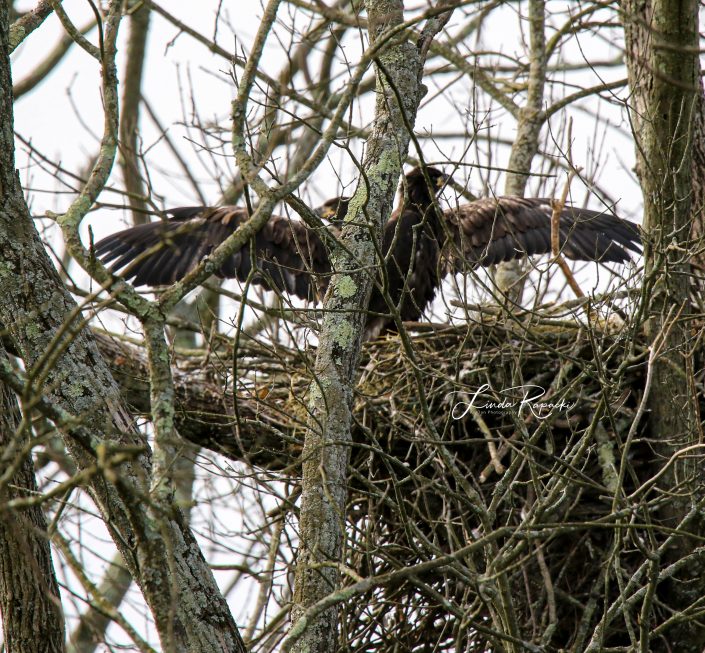
Found! Duke’s Tracker Reboots
by Barbara McKee, NJ Eagle Project Volunteer
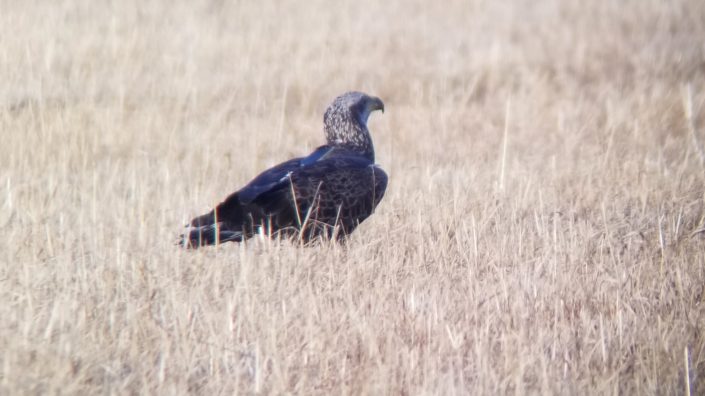
A year ago November I began tracking Duke. I was fortunate to see and photograph him more than a dozen times and wrote two blogs for CWF about these adventures.
See “Duke’s Homecoming” and “Playing Hide and Seek with an Eagle”.
Continue reading “Found! Duke’s Tracker Reboots”Where’s Duke?
By Barb McKee, New Jersey Eagle Project Volunteer
August 1, 2021. It is raining and dreary out. Indoors all day wrapping up my end-of-season raptor time/mileage sheets, I have cabin fever! Tracking Duke for the last nine months has been educational and fun, and right now I know that he is nearby. For the last week he has been perching along the Raritan river–very close to my home and adjacent to his natal home, Duke Farms in Hillsborough. I have been too busy to spend as much time as I would like hiking and biking along the river nearby, while playing “hide and seek” with Duke! I check the internet link for today’s confirmation. Sure enough, Duke is perched in a wide-open field on Duke Farms land that I know well. It is only 4 miles away so I get in the car and head over there. Because it is raining, my chances of spotting him might be pretty good since eagles prefer not to fly in the rain, but rather remain on their perches without moving. He might still be there! I anticipate success. There he is! Right where I thought he would be. In a small grouping of trees in the middle of this large field there is one dead tree front and center, and Duke, fortunately, is perched on the dead tree, easily seen from the road. The photos are shot from about 100 yards away, in a light rain, but it is still a thrill to see him as it has been exactly two months since I last saw him on June 1st. blog post (Playing Hide and Seek with an Eagle)

On August 2, I learned that Duke had flown from that Duke Farms field back to the Delaware River and to Tohickon Creek where he spent the first week in August. As the second week began, his transmitter skipped 2 consecutive days of downloading data, but and when it finally did download, he had flown back to Duke Farms! In the coming days he seemed restless. He did not hunker down in one area, but appeared to be revisiting all of his haunts and hang-outs in central Jersey from the last nine months. He even went back to Tewksbury, flew very close to his winter “restaurant”, the game fowl pens at Flint Hill Hunting Preserve, and did a huge circle over Bedminster! He checked out Round Valley, the Black/Lamington River, Eagle Bend on the North Branch, and explored that river from Far Hills all the way to route 22. Then on August 30, a travel day again, he flew back to the Delaware! Again his transmitter did not connect with the satellite on the last day in August, but when it finally did connect, it was clear that his restlessness continued.
During the torrential rains of hurricane Ida, Duke finally hunkered down in PA on Neshaminy creek west of Washington Crossing in a rural area of woods and fields. He remained there until Sept. 6 when he flew back to the Delaware River and perched right near my Bulls Island nest. That is where he was on Sept 7. Then….his transmitter skipped three days of downloading! Finally, on Sept. 10, 72 hours of data downloaded and it showed he had been back on Tohickon Creek. This is a wild stream in a wooded gorge. There are some roads and houses here and there, but it is mostly rural–a good place for a young eagle. There would be plenty of places to perch and roost, and fish and small animals in and by the river to eat. But then, after 3:03:08 pm Eastern Daylight Time on September 10, his transmitter went dark!

My adventures with Duke started exactly a year ago today! blog post (Duke’s Homecoming) I learned he can hold his own against competition for food, aggressively steal from lesser raptors, find small rodents, reptiles and other prey in the smallest of creeks and valleys, fly beautifully and roost safely during rain, wind and snow. I have watched him thrive as an independent eagle in the wild, and although I sometimes worried about his choice of perches and food sources, I believe he has a great chance of reaching maturity and, in about 2 years, with his head and tail feathers mostly white, find a territory he likes and a mate with whom to build a nest. I miss knowing where he has been and miss our games of hide and seek. It has been 57 days since his last data download. I trust from the information on the site that his solar battery has failed and that Duke himself has not failed! During the coming winter I will be searching all the places I know he preferred. I believe eagles are creatures of habit. As I watched him travel around, sometimes all the way to the Chesapeake and back, I am sure that he used his eagle eyes to spot landmarks which are his “road maps” when he travels. I have plenty of reason to believe that he will return to his favorite roosts and hang out and I will have my eyes open, still searching for him. My sincere hope is that I, or someone else, will someday catch a photo of him with his E/88 band easily readable!
In the meantime, soar safely Duke, fly high and free.
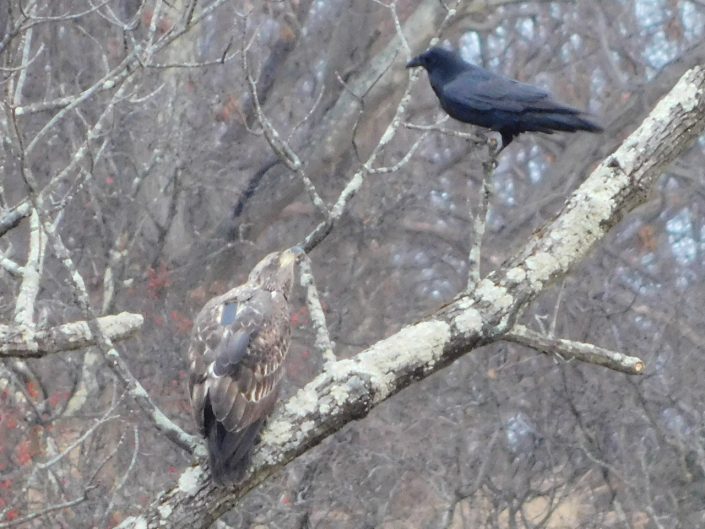
December 4, 2020 by Barb McKee 
January 5th, 2020 by Barb McKee 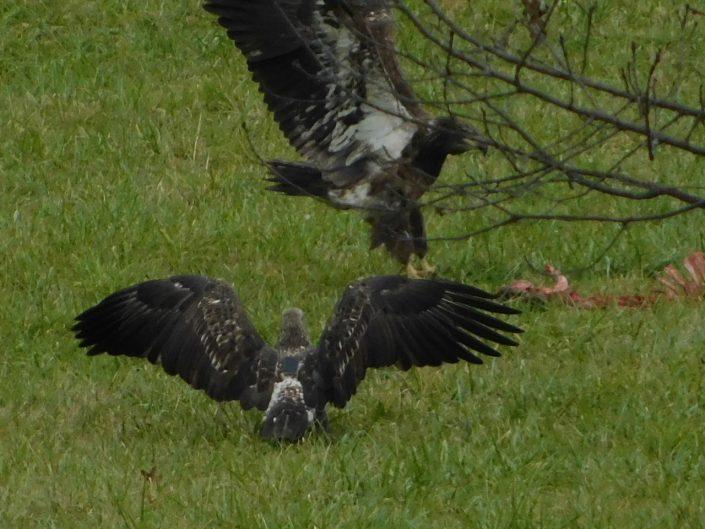
December 4, 2020 by Barb McKee
- Blog post: Duke’s Homecoming
- Blog post: Playing Hide and Seek with an Eagle
- New Jersey Eagle Trax
Eagles, Vultures and a Kitten
By: CWF biologist Larissa Smith
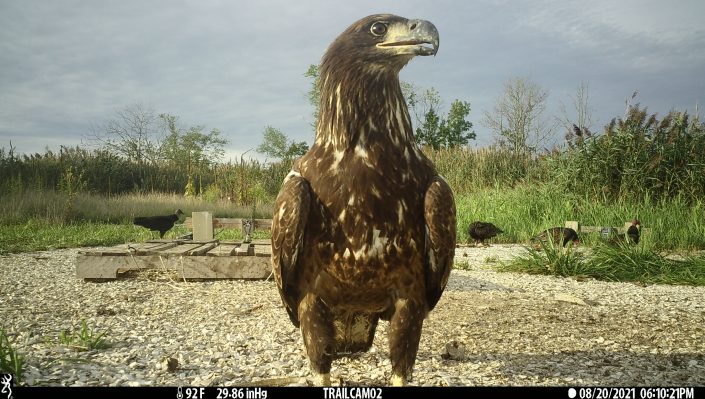
This is the second year that the NJ Endangered & Nongame Species program along with the Conserve Wildlife Foundation of NJ have set up a “soft release” area for juvenile eagles that were found grounded and cared for at Rehabilitation centers. The site is in a remote area of Cumberland County where staff and volunteers provide supplemental food (fish and road-killed mammals) in a safe place, and where other juvenile and sub-adult eagles would provide the social learning they needed. Trail cameras were installed to document eagle use.
Continue reading “Eagles, Vultures and a Kitten”Part 7: Three Bridges Eagle Update
by: Larissa Smith, CWF biologist

This eagle nesting season we have been following the story of the Three Bridges eagle pair in a blog series. A camera on the nest allowed viewers to get an up-close view of the nesting activities. The pair successfully raised two chicks, who biologists banded (green bands H/04 & H/05), and they fledged the end of June.
On July 4th, eagle H/05, was found injured near the nest. He was taken to The Raptor Trust where he was treated for a fracture of the left coracoid bone, which supports powered flight in the wing. He remained in the care of The Raptor Trust until he was fully healed and had regained some of his flight strength.
Three Bridges nest monitors continued to observe the nest area and determined that the adults and H/04 were still around the nest platform. In a very quick and quiet manner, H/05 was released back at the nest site last past week. It was necessary to have adults in the area, so he can continue his post-fledging period with them, learning to hunt and survive on his own.

Since his release, H/05 has been seen flying and perching in the nest area. It is very important for people to view the nest platform from a distance and not approach the nest tower or any eagles perched in the area. We all need to keep this nest area “eagle-safe” for the next month, giving H/05 and his family time to reacquaint and re-learn eagle skills! We thank everyone who has supported this eagle family.
- Read the Three Bridges Blog Series: Part 1, Part 2, Part 3, Part 4, Part 5 & Part 6.
- Three Bridges Eagle Cam
- Donate to the NJ Eagle Project
‘An Act of Love’: A Tribute to a Selfless Eagle Volunteer
Guest post by Kathy Clark, State Endangered and Nongame Species Program

We in the Bald Eagle Project lost a dear friend in November, 2020, when Mary Jane Horner passed away unexpectedly. Mary Jane, along with her husband Red, of Pittsgrove, New Jersey, were among the very first eagle volunteers, getting involved in the project in 1993 when there were just six nests in the entire state of New Jersey. Like so many of us at the time, she learned about bald eagles by spending a lot of time watching them, and became a field expert!
The 1990s were early, formative years for the eagle program, and Mary Jane and Red were part of building the foundation of a program that thrives today. Mary Jane was a strong “force of nature” for bald eagles! She was direct and persistent, while always being kind and polite. She called out wrongs and worked consistently for the highest level of protection for her eagles and nests.

Her quiet tenacity worked! Mary Jane, with Red always at her side, helped engage local landowners and neighbors, and over the years a handful of nests multiplied.
During their busiest seasons, Mary Jane and Red monitored at least ten nests, and she could tell you every detail of each nest and their milestones! Mary Jane’s dedication to bald eagles in south Jersey was in every way an act of love – for bald eagles and for the natural world.
I will miss Mary Jane very much. Her quiet and kind demeanor, her steadfast devotion, and her friendship with me and many of us in the program will remain in my memory.

We encourage those who wish to share memories of Mary Jane to do so in the comments below and on her obituary page.
Kathy Clark is the Supervising Zoologist for the New Jersey Division of Fish and Wildlife’s Endangered and Nongame Species Program, which runs the New Jersey Bald Eagle Project in partnership with Conserve Wildlife Foundation of New Jersey.
Part 2: An eagle nest reinstalled
by: CWF biologist Larissa Smith
In Part one of this blog series the Three Bridges eagle nest was removed from the transmission tower. The tower was then dismantled. The next step was the installation of the new tower. This tower design is different then the old tower which had a lattice structure on top where the eagles built their nest. Since this new tower didn’t have have the same structure to support a nest, an eagle nest platform was designed and built .

New tower 11/22/20@ Mary Ellen Hill 
Stringing lines 12/1/20@ Barb McKee 
nest platform ready for installation @ Claudia Rocca
During the entire procedure the Three Bridges eagle nest monitors recorded the eagle pairs activities. They were often perched on the nearby towers watching the activity. Nest monitor Mary Ellen Hill saw one of the eagles fly over to the new pole and hover above before flying back to another tower.

On a cold, snowy day the eagle nest was placed into the nest platform. The nest platform was then hoisted up to the arm of the tower and bolted in place. Now we wait and see if the pair will return and nest in their “old” nest on the new nest platform and tower.

Platform with nest @ Joe Mish 
platform installation@ Daniel Kroon 
platform installation @ Barb McKee 
Platform installed@ Mary Ellen Hill
Thank you to all the Eagle Project volunteers who monitor this nest and PSE &G employees who have worked hard to finish this project before eagle nesting season.